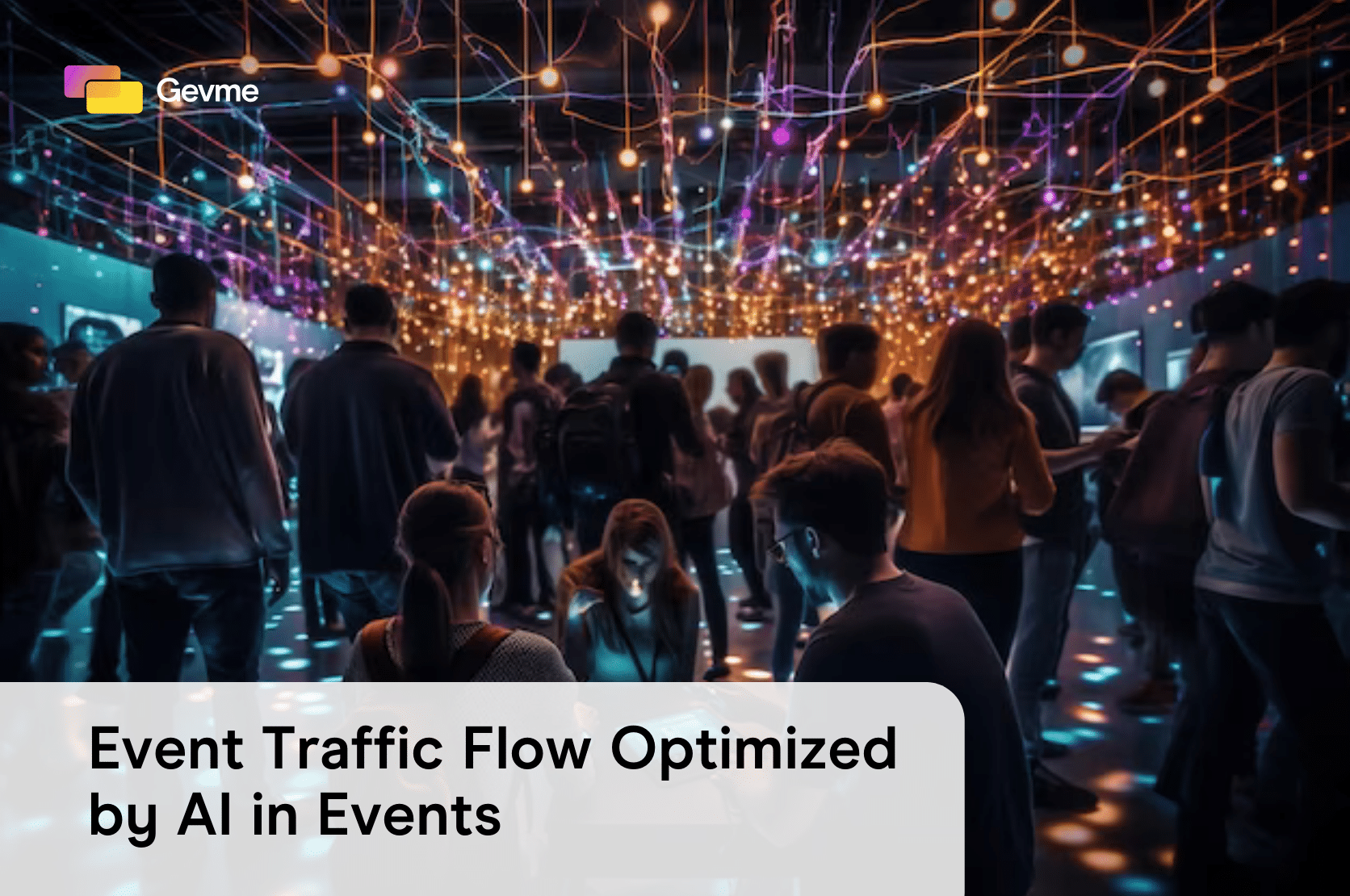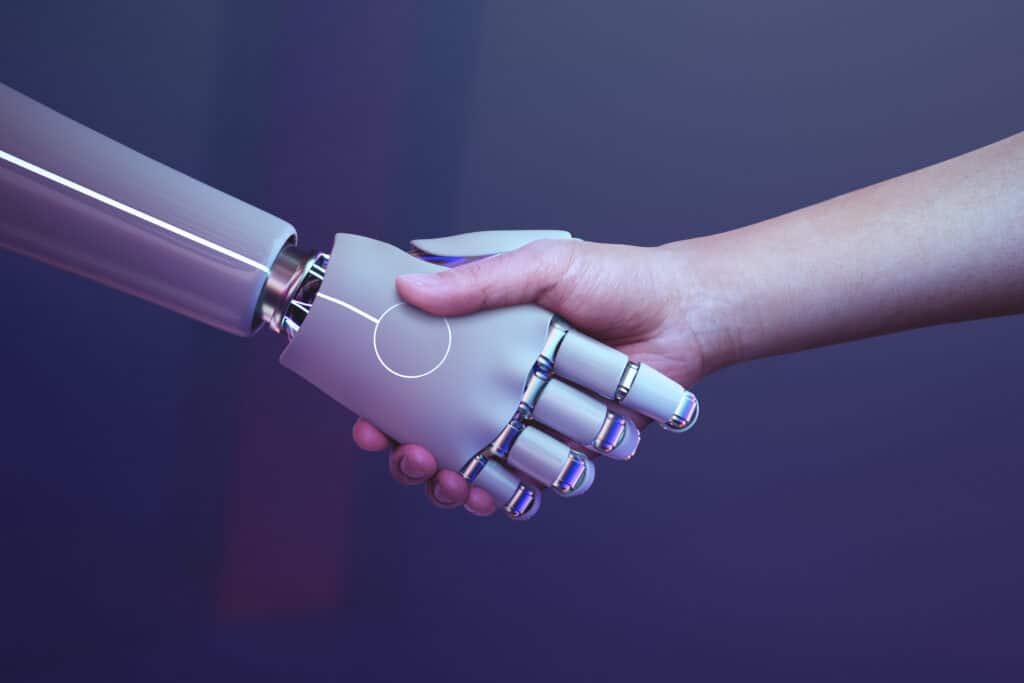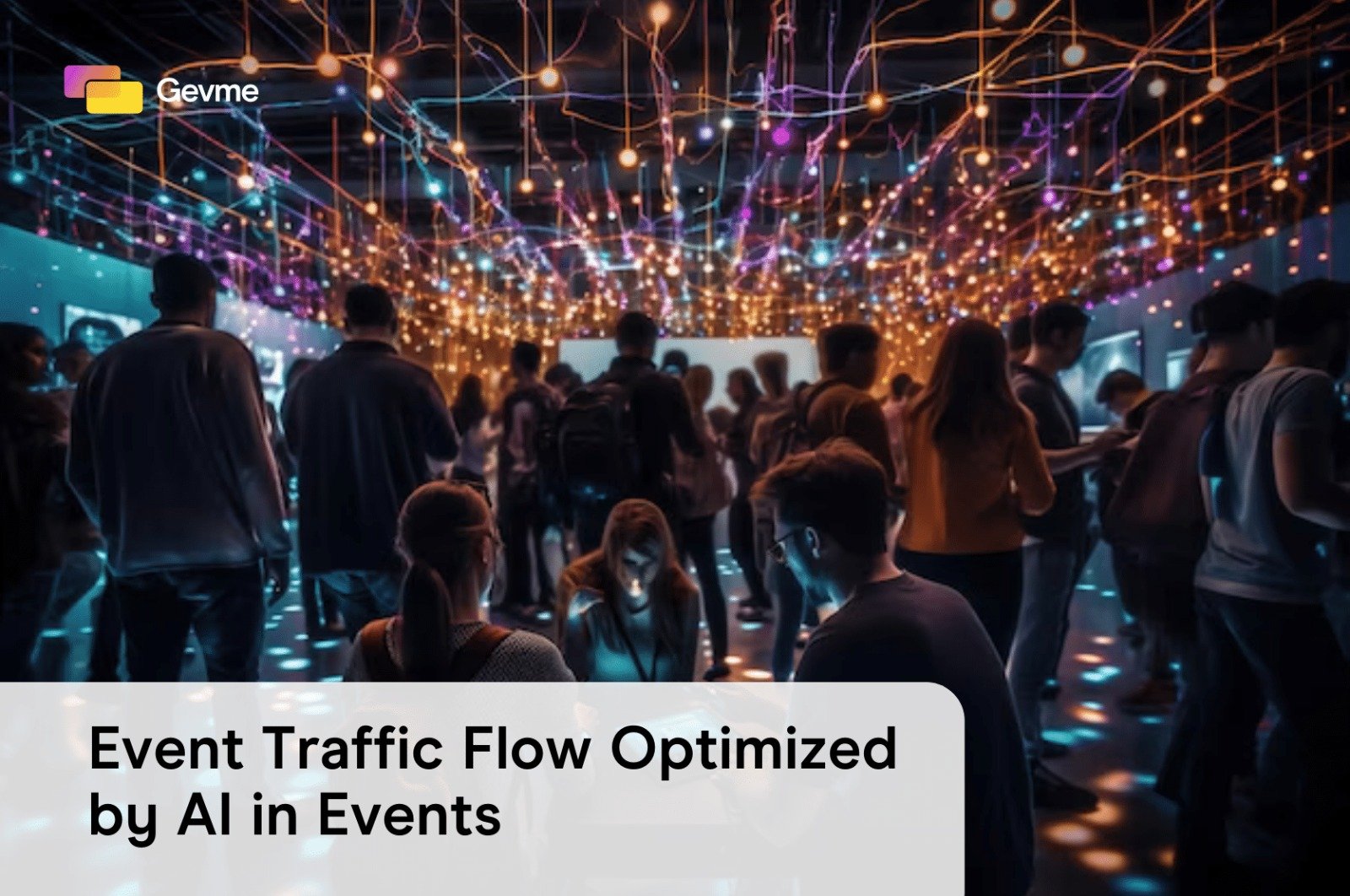Effective traffic flow is crucial in event management, directly impacting attendee experience and overall event success. With the advent of

Effective traffic flow is crucial in event management, directly impacting attendee experience and overall event success. With the advent of AI in event management, optimizing event traffic flow has taken a significant leap forward.
This blog explores the transformative role of AI in events, particularly in managing event traffic flow, from analyzing attendee movement patterns to making real-time adjustments. AI’s integration into traffic management not only streamlines attendee movement but also enhances safety and efficiency, marking a new era in sophisticated event planning.

Understanding Event Traffic Flow Challenges
Mastering event traffic flow is essential for smooth event experiences, involving intricate attendee dynamics and complex venue layouts.
- Diverse Attendee Dynamics: Effective event traffic flow management requires a deep understanding of varying attendee dynamics. This includes recognizing patterns such as early arrivals, preferences for keynotes versus workshops, and movement tendencies during breaks. Different types of events attract different crowd behaviors – understanding these nuances is key to predicting and managing traffic flow effectively.
- Venue Layout Complexity: Each venue’s unique layout, from multi-level conference centers to sprawling outdoor spaces, presents specific traffic management challenges. Navigating these complexities involves understanding the flow between entrance points, session rooms, exhibit areas, and amenities like restrooms and food courts. Strategic placement of signs and staff to guide attendees is crucial, especially in venues with intricate layouts or multiple event spaces.
- Peak Time Congestion: Managing traffic during peak times demands strategic planning. This involves staggered scheduling of sessions to avoid simultaneous starts and ends, creating multiple paths to popular areas to disperse crowds, and having contingency plans for unexpected surges in attendee movement.
- Safety and Accessibility Considerations: Ensuring safety and accessibility is multifaceted – it involves not only adhering to safety regulations but also creating an inclusive environment for all attendees. This includes designing routes that are accessible for people with disabilities, planning for medical emergencies, and ensuring that safety protocols are clearly communicated and easily accessible.
- Emergency Situations: Planning for emergencies involves comprehensive strategies that account for various scenarios – from medical emergencies to security threats. This includes having clear evacuation routes, trained staff ready to guide attendees, and effective communication channels to rapidly disseminate information.
- Integrating Multiple Areas: Coordinating traffic flow across different event areas requires a holistic view of the event space. It involves understanding how attendees move from keynotes to breakout sessions, managing flow to dining and networking areas, and ensuring that these transitions are smooth and do not create bottlenecks.

AI in Events for Traffic Flow Analysis
By employing advanced data collection and analytics, AI provides invaluable insights into how traffic flows within an event:
- Data Collection and Analysis: AI in event management excels in gathering detailed data on attendee movements using advanced technologies like sensors, beacons, and mobile apps. This data collection extends beyond simple movement tracking, analyzing patterns, speed, and even attendee preferences in real time, providing a comprehensive view of traffic flow.
- Identifying Bottlenecks: Utilizing AI algorithms, potential bottlenecks and high-traffic zones within the event space are rapidly identified. These systems can analyze various factors contributing to congestion, such as session timings, layout design, and attendee distribution, offering actionable insights to mitigate these issues.
- Optimizing Pathways and Directions: AI-driven analysis helps in dynamically optimizing pathways within the event. This involves not just rerouting traffic to less congested areas but also adjusting the overall layout in real-time based on ongoing traffic flow analysis.
- Heat Mapping for Crowd Density: AI technologies create detailed heat maps indicating crowd density in various event areas. This mapping is crucial for understanding which parts of the event are most crowded at different times, aiding in efficient crowd control and enhancing attendee comfort.
- Predictive Analysis for Future Events: The predictive power of AI extends to anticipating traffic flow challenges for future events. By analyzing historical data, AI can forecast potential traffic issues and recommend improved traffic management strategies for upcoming events.
- Customized Reports for Event Planners: AI tools provide event planners with in-depth, customized reports. These reports contain valuable insights on traffic flow, highlighting areas of success and those needing improvement, and offering data-driven recommendations for future events.

Real-time Crowd Management with AI
By leveraging AI in events, the event organizers can manage large groups more efficiently, ensuring safety and a seamless experience:
- Monitoring Crowd Dynamics: AI systems not only monitor but also analyze crowd movements using a network of cameras and sensors. This analysis includes tracking the speed of movement, identifying high-density areas, and predicting potential bottlenecks before they occur, allowing for preemptive action to manage crowd flow.
- Dynamic Space Management: AI dynamically manages venue space by automatically adjusting layouts in response to real-time crowd data. It can open or close sections of the venue, reroute attendees through alternative paths, and manage entry and exit points to optimize traffic flow and minimize congestion.
- Automated Alerts and Notifications: AI systems send targeted alerts and notifications to both attendees and staff. These are not just limited to congestion alerts but also include updates on schedule changes, capacity limits, and other relevant information to ensure a smooth event experience.
- Integration with Security Systems: AI’s integration extends to enhancing security by monitoring crowd behaviors for potential threats, coordinating with emergency services for rapid response, and using advanced surveillance techniques like facial recognition for enhanced safety.
- Facilitating Emergency Responses: AI systems play a critical role in emergencies by quickly analyzing the best evacuation routes, considering factors like crowd size, location, and the nature of the emergency, ensuring the safest and most efficient evacuation process.
- Personalized Attendee Guidance: AI-enhanced apps can provide attendees with real-time updates on session availability, wait times, and even recommend the best times to visit popular areas, reducing the likelihood of overcrowding and enhancing the overall event experience.

Predictive Analytics for Pre-Event Planning
Predictive analytics, powered by AI, are reshaping strategic event preparations, offering foresight for effective planning.
- Forecasting Attendee Numbers: AI’s predictive capabilities extend to accurately forecasting attendee numbers, analyzing historical data and current trends. This enables precise planning for seating, catering, and other resources, ensuring the event is neither over nor under-resourced.
- Anticipating Traffic Flow Patterns: AI analyzes past events and current registration data to predict traffic flow patterns, helping in designing layouts that minimize congestion and improve attendee mobility.
- Session and Activity Planning: AI helps in balancing attendee interest and capacity constraints by predicting popular sessions and activities, aiding in schedule optimization and space management.
- Resource and Staffing Predictions: AI’s predictive analytics forecast the need for resources and staffing, ensuring the event is well-equipped and staffed efficiently to handle all aspects, from registration to customer service.
- Emergency Preparedness: Predictive analysis identifies potential risk areas, aiding in the development of comprehensive emergency and contingency plans, ensuring quick and efficient responses to unforeseen situations.
- Vendor and Supply Chain Management: By anticipating vendor and supply chain demands, AI aids in efficient logistics management, helping to avoid last-minute shortages or excesses and ensuring smooth operations.

AI-Driven Signage and Directions
AI revolutionizes event navigation, enhancing signage and directional guidance for simplified attendee experiences.
- Dynamic Signage Adaptation: AI’s dynamic signage adaptation involves analyzing attendee movement patterns in real-time, adjusting messages on digital signs to redirect traffic, and even changing signage content based on the time of day or specific event schedules.
- Personalized Directional Assistance: AI integration in event apps offers a level of personalization where attendees receive tailored navigation paths based on their location, schedule preferences, and even past behavior at the event, ensuring a smooth and personalized experience.
- Real-time Traffic Updates: AI systems continuously monitor and analyze attendee flow, providing real-time updates to prevent congestion. This involves directing traffic to alternative routes and updating attendees about the best times to visit certain areas or amenities.
- Interactive Signage Solutions: AI-driven interactive signage goes beyond traditional navigation, offering engaging content like interactive event timelines, personalized session recommendations, and even gamified navigation challenges.
- Predictive Signage Placement: AI’s predictive analysis for signage placement considers historical data, attendee feedback, and real-time movement patterns to strategically place digital and physical signs where they are most needed and visible.
- Accessibility Enhancements: AI-driven signage systems can automatically adjust for various accessibility needs, offering features like sign language interpretation, audio descriptions, and high-contrast visual displays for better accessibility.
Integrating AI with Event Apps
The integration of AI in event management is revolutionizing the functionality and effectiveness of event apps, making them not just tools but personal assistants for attendees.
- Seamless App Integration: The integration of AI in event apps goes beyond basic functionality, enhancing user experience with features like adaptive interfaces, personalized content based on attendee behavior, predictive suggestions, and intuitive navigation. This results in a highly efficient and tailored experience for each attendee.
- Customized Attendee Itineraries: AI-driven apps craft detailed itineraries by analyzing a wealth of data, including attendee preferences, session popularity, real-time location, and even social interactions, to suggest the most relevant sessions, meet-ups, and activities.
- Real-time Notifications and Updates: These apps provide not just notifications about schedule changes, but also real-time updates on various aspects like session seat availability, queue lengths at facilities, and venue traffic conditions, ensuring attendees have all the necessary information for a smooth experience.
- Enhanced Engagement Features: AI in event apps enhances attendee engagement by facilitating intelligent networking opportunities, interactive features like live polling and session feedback, and personalized content delivery based on attendee preferences and behavior.
- Feedback and Improvement Mechanisms: AI-enabled apps actively gather and analyze feedback, utilizing techniques like sentiment analysis to understand attendee satisfaction and areas needing improvement, enabling real-time adjustments and long-term planning insights.
- Data Analysis for Future Events: After the event, AI analyzes app data comprehensively to provide insights into attendee behaviors, engagement patterns, and preferences. This data is invaluable for refining strategies and enhancing future event planning and execution.

Safety and Emergency Management
AI elevates safety standards and emergency responses at events, ensuring effective crowd control and quick action during crises.
- Enhanced Safety Protocols: AI’s role in safety involves advanced monitoring of crowd densities and movements, swiftly identifying potential hazards such as overcrowding or blocked exits. It enables quick activation of safety protocols, like directing crowds to less congested areas or issuing alerts.
- Emergency Situation Management: In emergencies, AI’s rapid data processing capabilities are crucial. It can analyze the situation, identify the safest evacuation routes, and guide attendees efficiently, minimizing chaos and enhancing safety.
- Real-time Communication: AI systems play a vital role in facilitating immediate communication during emergencies. They can send targeted messages to attendees in specific areas, provide real-time updates, and guide attendees with clear instructions for safety.
- Crowd Control in Emergencies: AI assists in managing crowd movements, using predictive analytics to anticipate areas of congestion and directing crowds in an orderly manner to prevent panic and ensure smooth evacuations.
- Post-Emergency Analysis: After an event, AI analyzes data to assess the effectiveness of emergency responses. This includes evaluating evacuation routes, response times, and overall crowd management, providing insights for future safety improvements.
- Collaboration with Emergency Services: AI can be integrated with local emergency services, enabling a more coordinated response. This includes sharing real-time data, assisting in resource allocation, and ensuring rapid and effective emergency handling.

Challenges and Limitations in AI Implementation
Navigating the complexities of AI integration in event management involves addressing technical, privacy, and cost challenges.
- Technical Integration Challenges: The integration of AI into event management systems can be complex and resource-intensive. This complexity extends to ensuring compatibility with existing technologies, training staff, and the potential need for frequent updates and maintenance.
- Data Privacy and Security: With AI’s reliance on personal data, ensuring data privacy is critical. This involves complying with various international data protection regulations, implementing advanced cybersecurity measures, and regularly updating these measures to tackle evolving cyber threats.
- Dependence on Quality Data: The success of AI systems heavily depends on the quality of data. Poor data quality can lead to inaccurate insights and ineffective traffic management strategies, necessitating robust data collection and processing protocols.
- Cost Implications: The cost of implementing AI solutions can be prohibitive, especially for smaller organizers. This includes expenses for technology acquisition, integration, maintenance, and the need for skilled personnel to manage AI systems.
- Adapting to Rapid Technological Changes: AI in event management is a rapidly evolving field, requiring continuous learning, training, and investment in new technologies to stay current and effective.
- Balancing AI and Human Judgment: Achieving the right mix of AI automation and human oversight is a nuanced challenge. It involves ensuring that AI complements human expertise without overriding the essential human elements of event management.
The Future of AI in Event Traffic Management
The evolving landscape of AI in event management promises advanced, streamlined approaches to event traffic management, hinting at an innovative future.
- Advancements in AI Algorithms: Future AI will likely bring more advanced algorithms, enhancing accuracy in predicting attendee movements and optimizing traffic flow. These developments will allow for real-time adjustments and highly accurate forecasting of potential congestion points.
- Integration with Emerging Tech: AI’s integration with technologies like IoT and smart city infrastructures will further enhance traffic management. This could include smart sensors throughout event venues and cities, providing comprehensive data for AI analysis.
- Autonomous Traffic Control Systems: We might witness the emergence of fully autonomous traffic control systems in venues, where AI independently manages all aspects of traffic flow, reducing the need for manual intervention and increasing efficiency.
- Enhanced Personalization: Future AI is expected to offer hyper-personalized navigation assistance, taking into account individual attendee schedules, preferences, and even real-time physical conditions for optimized routing.
- AI in Post-Event Analysis: AI tools will provide deeper insights in post-event analysis, evaluating traffic flow effectiveness, attendee satisfaction with navigation, and identifying areas for improvement in future events.

Conclusion
The integration of AI in event traffic management marks a significant stride towards more efficient and attendee-centric events. As we’ve seen, AI offers innovative solutions to complex challenges, ensuring smoother and safer events. Platforms like Gevme are already harnessing AI to enhance their event solutions, setting a benchmark in the industry. The future, undoubtedly influenced by AI, promises events that are not only well-organized but also highly personalized and adaptable to the dynamic nature of large gatherings.

COMMENTS